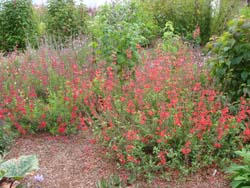Quick Digs: Spring Weeds in Salvia Gardens

This is the fourth article in our Quick Digs series about preparing for spring in Salvia gardens. Previous posts covered topics such as maintaining a garden calendar and use of the Flowers by the Sea wish list registry. Now let's tangle with weeds.
Getting ready for the emergence of previously planted perennials in spring and for planting new sages (Salvia spp.) requires weeding before amending soil and planting. Then, growing vigorously spreading sages and ones rich in aromatic plant chemicals can help control weeds.
Battling with Hoe and Hand
Vanquishing invasive plants in an ecofriendly way requires hoeing and hand weeding so that weeds don't crowd sages and thwart growth.
Early spring is the best time to get started, because many weeds have shallow roots at the beginning of the growing season. Yet some weeds grow deep, such as dandelions (Taraxacum spp.) with long taproots that awaken from winter slumber for a return engagement.
Herbicides don't work well against dandelions and also can harm other plantings. So one of the best removal methods is the old technique of surveying your yard repeatedly for their cheerful yellow flowers and digging them up before they turn into seed bombs. If you don't already have one, you need a forked tool called a dandy digger that looks a bit like a screwdriver.
But the absolute best way to decrease weeds is to provide effective competition. If you have a lawn, the turf needs to be thick and healthy to crowd out weeds that spread to other parts of the landscape. Or you can grow lots of groundcovers and flowerbeds filled with tenacious species, including sages.
Nipping Weeds Before They Emerge
A number of Salvia species have been studied for what appears to be an allopathic ability to discourage weeds. Allopathy involves plants that exude chemicals -- whether from their foliage or roots -- which make it difficult for other plants to grow nearby.
Researchers have focused on the weed-fighting abilities of aromatic Salvia chemicals called terpines, which are related to turpentine. Terpines don't necessarily make a plant smell like turpentine. Otherwise the terpine-rich mint family (Lamiaceae), to which the Salvia genus belongs, might have a less pleasant name.
One study, in particular, found that Salvias such as Autumn Sage (Salvia greggii) and Black Sage (S. mellifera) keep seeds of other plants from germinating. Click here for more information about the study.
Planting a Strong Defense
As previously mentioned, it's best to defend your green space by going on the offense. Filling your landscape with long-blooming, tenacious perennials -- especially groundcover sages -- makes it difficult for weeds to take hold.
Some of these sages are only a few inches tall whereas others may reach up to your knees or higher and also work well as border plants. Some, including the Hummingbird Sages (S. spathacea spp.) thrive in full shade with little water. You can plant them under trees.
Questing for Answers to Questions
When you quest for plants to solve a particular problem in your yard, you often have questions. This is especially true if you are considering a genus, such as Salvia, in which there are approximately 1,000 species.
Little information is available online or in most garden catalogs about many of the species that are now being grown commercially, so it helps to talk with Salvia specialists. That's what we are. We're ready to answer your questions, so please contact us.
Updated March 19, 2018
By Alicia Rudnicki, FBTS Staff Writer

 Salvia mellifera 'Terra Seca'
Salvia mellifera 'Terra Seca'  Salvia mellifera 'Jade Carpet'
Salvia mellifera 'Jade Carpet'  Salvia mellifera
Salvia mellifera
Comments
There are no comments yet.